Scythe Infinity: 5 Heatpipes and Silent 120mm Fan
by Wesley Fink on February 26, 2007 12:05 AM EST- Posted in
- Cases/Cooling/PSUs
Scythe Infinity
Scythe Co., Ltd. is a Japanese company located in Tokyo. Beginning in 2002 Scythe started manufacturing and distributing products for the PC enthusiast. This included CPU cooling solutions. Scythe's first product, the Scythe Samurai, developed quite a reputation among computer enthusiasts.
Scythe produces a wide range of air cooling solutions for the computer enthusiast. There are currently about a dozen air cooling solutions detailed on the company website. These range from entry cooling solutions all the way to full cooling tower designs.
Their current catalog includes the well-known Scythe Infinity and the Scythe Ninja Rev. B full cooling tower solutions at the top. There are also mid to low-end offerings such as the Scythe Katana that was recently reviewed at AnandTech.
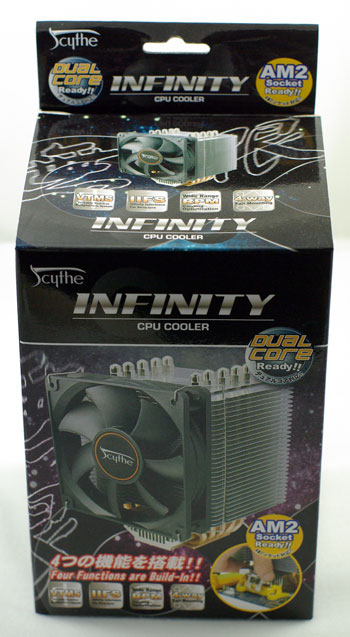
Scythe likes using colorful graphics, but they often put so much information in so many languages on the box that the packaging becomes confusing. The Infinity is a big heatpipe tower, and Scythe use every inch of that big package for information. You can find whatever you want to know about Infinity on the package somewhere - it's just finding what you are looking for is not so easy in that package information explosion.
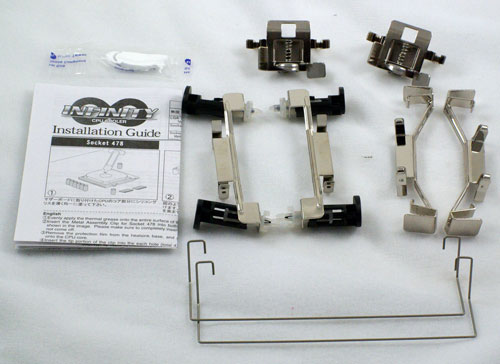
Infinity comes with adapters for 775, AM2, and AMD 754/939/940. The Scythe adapter system is extremely easy to use. Adapters pop into holes on the side of the tower base and no tools are needed for mounting the adapters. It's a very clever mount system.
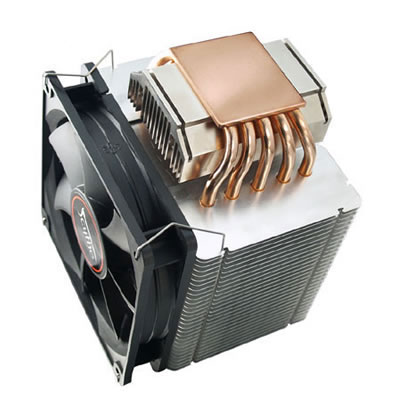
The mounting surface of Infinity is highly polished. It is protected during shipments with an adhesive film that removes leaving no residue.

At first glance it looks as if the Scythe Infinity uses ten heatpipes for cooling, but Scythe specifies the configuration as five heat pipes. The 5 pipes flatten out and pass across the base copper plate, so they form a continuous "U" shape with each heatpipe.
Scythe supplies a packet of very basic thermal compound with the Infinity, but it is nothing special. We used our standard silver-colored thermal grease in our testing, which is what we use in testing all coolers unless they supply a high-end thermal grease with the cooler.
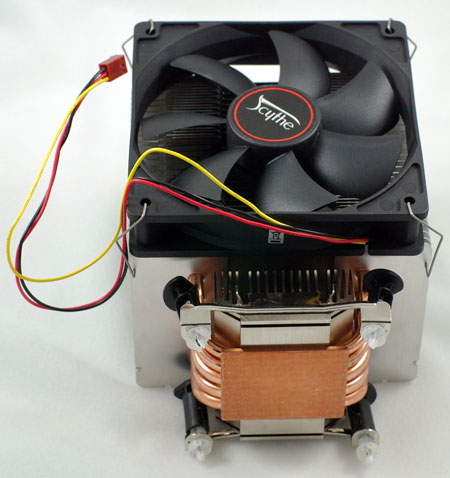
The included low-noise fan can fit on any of the 4 sides of the cooler. Scythe tells us mounting on the larger side of the Infinity provides the best cooling, but the fan may also be mounted on the shorter side if that works better in your configuration.
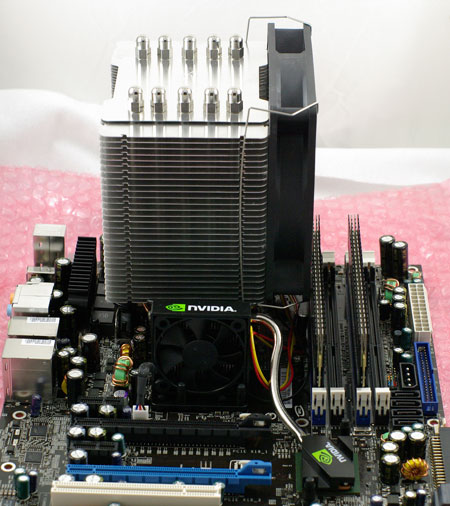
Installation is very easy after the mounting plate is installed. The 775 mount uses push pins - just like the Intel retail design. However easy the mount is, the fact that the Infinity weighs right at 2.2 lbs, or a kilogram, gives reason for pause. It is very uncomfortable having so much weight held by just those pop clips. The Infinity is probably OK in a desktop case, but it is not a mounting system that handles moving the case around or transport to and from a LAN party.
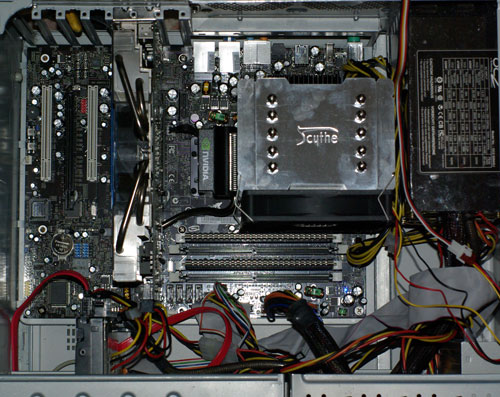
The Infinity does not overhang the DIMM sockets on the EVGA 680i as you can see in the picture above. The fan does come very close however. The mass of the Infinity is also a bit closer to the motherboard than some other heatpipe towers, so the Infinity can be a tight fit on some motherboards. In our installation the EVGA cooling fan on the Northbridge touched the Infinity, meaning the Infinity has to be very carefully aligned on installation. In our first attempt stock idle cooling was 36C, which appeared very high. After a careful remount the stock idle temp dropped to 31C, which was more in line with expected performance.
Specifications
Our test system is Intel Socket 775, but the Scythe Infinity will mount on any current CPU, as already mentioned. All the needed hardware is included to fit the supported sockets.
One 120mm "silent" fan comes with the Scythe Infinity. The Infinity street price is $58, about the same as the current price of the Tuniq Tower 120. If you cannot find a local retailer or etailer that sells the Infinity you can order directly from Scythe USA for $58. Scythe also sells additional fan wires for about $2 per pair. Many etailers also stock the fan wire kits. Any 120mm x 25mm fan should mount on the Infinity. Scythe also manufactures a very large variety of cooling fans sold under the Scythe brand, including models that feature the Sony Fluid Dynamic Bearing. You will find many of these available at etailers like Newegg, 3DCool and Frozen CPU.
Scythe Co., Ltd. is a Japanese company located in Tokyo. Beginning in 2002 Scythe started manufacturing and distributing products for the PC enthusiast. This included CPU cooling solutions. Scythe's first product, the Scythe Samurai, developed quite a reputation among computer enthusiasts.
Scythe produces a wide range of air cooling solutions for the computer enthusiast. There are currently about a dozen air cooling solutions detailed on the company website. These range from entry cooling solutions all the way to full cooling tower designs.
Their current catalog includes the well-known Scythe Infinity and the Scythe Ninja Rev. B full cooling tower solutions at the top. There are also mid to low-end offerings such as the Scythe Katana that was recently reviewed at AnandTech.

Scythe likes using colorful graphics, but they often put so much information in so many languages on the box that the packaging becomes confusing. The Infinity is a big heatpipe tower, and Scythe use every inch of that big package for information. You can find whatever you want to know about Infinity on the package somewhere - it's just finding what you are looking for is not so easy in that package information explosion.

Infinity comes with adapters for 775, AM2, and AMD 754/939/940. The Scythe adapter system is extremely easy to use. Adapters pop into holes on the side of the tower base and no tools are needed for mounting the adapters. It's a very clever mount system.

The mounting surface of Infinity is highly polished. It is protected during shipments with an adhesive film that removes leaving no residue.

At first glance it looks as if the Scythe Infinity uses ten heatpipes for cooling, but Scythe specifies the configuration as five heat pipes. The 5 pipes flatten out and pass across the base copper plate, so they form a continuous "U" shape with each heatpipe.
Scythe supplies a packet of very basic thermal compound with the Infinity, but it is nothing special. We used our standard silver-colored thermal grease in our testing, which is what we use in testing all coolers unless they supply a high-end thermal grease with the cooler.

The included low-noise fan can fit on any of the 4 sides of the cooler. Scythe tells us mounting on the larger side of the Infinity provides the best cooling, but the fan may also be mounted on the shorter side if that works better in your configuration.

Installation is very easy after the mounting plate is installed. The 775 mount uses push pins - just like the Intel retail design. However easy the mount is, the fact that the Infinity weighs right at 2.2 lbs, or a kilogram, gives reason for pause. It is very uncomfortable having so much weight held by just those pop clips. The Infinity is probably OK in a desktop case, but it is not a mounting system that handles moving the case around or transport to and from a LAN party.

The Infinity does not overhang the DIMM sockets on the EVGA 680i as you can see in the picture above. The fan does come very close however. The mass of the Infinity is also a bit closer to the motherboard than some other heatpipe towers, so the Infinity can be a tight fit on some motherboards. In our installation the EVGA cooling fan on the Northbridge touched the Infinity, meaning the Infinity has to be very carefully aligned on installation. In our first attempt stock idle cooling was 36C, which appeared very high. After a careful remount the stock idle temp dropped to 31C, which was more in line with expected performance.
Specifications
Our test system is Intel Socket 775, but the Scythe Infinity will mount on any current CPU, as already mentioned. All the needed hardware is included to fit the supported sockets.
| Scythe Infinity Specifications | |
| Heatsink | |
| Dimensions | 116(L) X 125(W) X 160(H)mm (excluding fan) |
| Weight | 960g (including fan) |
| Material | Pure Copper and Aluminum |
| Fan Configuration | 4-way mount, up to four 120mm Fans can be mounted |
| Fan | |
| Fan Size | 120mm x 120mm x 25mm |
| Noise Level | 23.5 dB-A |
| Speed | 1200 rpm +/- 10% |
| Air Flow | 46.5 CFM |
One 120mm "silent" fan comes with the Scythe Infinity. The Infinity street price is $58, about the same as the current price of the Tuniq Tower 120. If you cannot find a local retailer or etailer that sells the Infinity you can order directly from Scythe USA for $58. Scythe also sells additional fan wires for about $2 per pair. Many etailers also stock the fan wire kits. Any 120mm x 25mm fan should mount on the Infinity. Scythe also manufactures a very large variety of cooling fans sold under the Scythe brand, including models that feature the Sony Fluid Dynamic Bearing. You will find many of these available at etailers like Newegg, 3DCool and Frozen CPU.










39 Comments
View All Comments
Zoomer - Thursday, March 1, 2007 - link
Could you try adding more than two fans, or perhaps blocking the sides of the heatsink so that air can't escape and see if it helps?I'm very interested. It appears that this unit requires a high(er) static pressure to work well.
yyrkoon - Monday, February 26, 2007 - link
These coolers, are all fine and dandy, but what about low profile coolers, that dont weight as much as the Golden Gate bridge ?Me, my personal case, is an Lian Li PC-G50 (silver, if you must know . . .), and the PSU sits right_above about half of the CPU. Silent is great, higher overclocking potential, is better still, but the bigger question is, why arent these companies working on anything that doesnt require special cases, or at the very least, cases that are so huge, you can not put them any place without having large amounts of room.
My case: 15" tall, looks great, is very functional, its just a terrible shame, that no one seems to be making low profile coolers, that would help me eek out a 310mhz + CPU on my ABIT NF-M2 nView + AM2 Opteron 1210 (which I have actually achieved, just wouldnt do much other than BSoD within windows).
Lem - Wednesday, February 28, 2007 - link
Have you checked the Thermalright "SI-type" coolers? I have been happy with a Thermalright SI-120 + 120mm 1200rpm fan (PAPST 4412F/2GLL). I am not much into overclocking though. I only raised the frequency of my X2 3800+ to 2.4GHz because it was a nice round number that my RAM could handle.The newer SI-128 seems to support AM2-socket as well. I prefer that design over these for obvious reasons.
My Lian Li PC-61 is somewhat bigger than your case but I do not think that there would be any problems with PC-G50 either.
BigLan - Tuesday, February 27, 2007 - link
"why arent these companies working on anything that doesnt require special cases"Erm, your case is the special one. These coolers generally fit in standard atx cases, with the regular atx-approved layout (height might be an issue in mid-atx cases.) I think that having the psu above the cpu is ok for micro-atx, but that is still pretty specialized - you might want to look into server coolers (specifically 1-u coolers.) m-atx-style normally requires smaller fans, which have to spin much faster to move the same amount of air, and are very, very noisy (does anyone remember the old 60mm delta screamers?) You're also limited to fin area, which also hurts performance. There are some reasonably good btx coolers which overcome these problems though, but they're often proprietary (built into dell cases etc.)
cujo - Tuesday, February 27, 2007 - link
i love big cases. lots more room to work inside and lots more room for quiet 120mm fans.yyrkoon - Tuesday, February 27, 2007 - link
Good for you. My case also has silent 120mm fans, the system is so quiet in fact, I have to turn something else on, so I can sleep ( I require white noise to sleep ).arswihart - Monday, February 26, 2007 - link
I disagree with using overclocking as a measure of a heatsink's performance. You should focus on noise and temps, it's that simple. I don't know why anyone would even pay attention to that data you are presenting.Wesley Fink - Monday, February 26, 2007 - link
Temperatures at stock speeds are reported on p. 4. However, contrary to your assumption, coolers that perform best at cooling at a stock 2.93GHz are not always the same coolers that enable the highest overclock. Temperature rises as a CPU is overclocked, and coolers that perform well at stock speeds do not always remove heat as well at higher temperatures.Since the OC that can be achieved does not matter to you, the data on p.4 - temperature at stock speed - should give you what you are looking for.
arswihart - Monday, February 26, 2007 - link
Idle and Load temps for stock / OC. No need to look at 50Mhz differences to rank the heatsinks is my point.arswihart - Tuesday, February 27, 2007 - link
To further make my point, you see a 7 C difference between the single and dual fan configs on the Infinity, and only a 70Mhz difference in OC. To me, the 70Mhz difference is negligible, while the 7 C difference is quite striking.Relatively speaking, the difference in temps is much more drastic (12%), and much mnore relevant, than the difference you are seeing in OC (2%).
Do you still want to argue about it?
Sure it makes for interesting reading, so I guess I can't blame you too much, and the audience at Anandtech surely eats it up. I would just tell you I'd rather not have reviews cluttered up with this rather petty data.